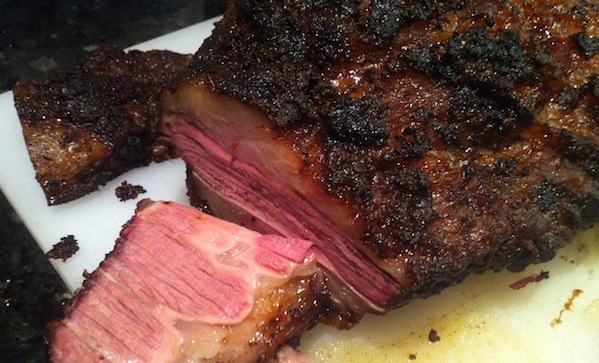If you’re into barbecue, I’d wager that your first grill was a Weber kettle grill or a knockoff thereof, and the first time you played with wood smoke involved a little smokebox. From there, dozens of grills and barbecues offer themselves to weekend pitmaster, from the massive to the tiny, from the ingenious to the practical. Here’s the thing, though: unless you’re going to quite your job and become a full-time pitmaster, the very last grill/smoker you’re going to buy is a Big Green Egg.
The Big Green Egg is what happened when American soldiers in Japan witnessed small, ceramic kamado-style barbecues and said, “This could smoke ribs.” What impressed them? Compared to metal, ceramics retain heat well, which means that a ceramic barbecue can build a much higher temperature, that food retains moisture better, and that much less fuel is used. The modern Egg is rounded out with excellent temperature control. There’s a vent at the bottom and a vent at the top. Add natural charcoal, maybe a single oak or pecan log, and you can maintain an accurate temperature for damn near as long as you like. How hot? I’ve had it up to 900°F. The literature says that 1200°F is possible.
The first time I used the Egg, I had pork ribs smoking at 225°F for four hours. The first time my dad used it, he threw some pork shoulders in there at 200°F, and never had to adjust the temperature once he set it. Twelve hours later, he had the easiest pulled pork he’d ever made.
This is why I say that the Big Green Egg will be the last grill/smoker that a weekend pitmaster will ever buy. Any pitmaster will tell you that technique is everything; that’s why they’re so willing to share their recipes. They know that any barely literate jackass can throw together a rub, but only a master can keep an even temperature for the many long hours it takes to smoke something properly. In many ways, the Big Green Egg removes the need for that careful fire-tending skill.
The Egg comes in five sizes, from the mini, with a nine and a half inch grill, to the extra large, which has a twenty-four inch grill and weighs in at two hundred pounds. It also has a boatload of accessories (PDF warning), from “nests” (i.e., stands) to multiple tier grills, to ceramics for baking or turning your Egg into a pizza oven, to ceramic plates for maintaining indirect heat and turning your Egg into a smoker.
Here is the downside: none of this is cheap. The mini starts around $350, and larger sizes go for well over $1,000—exact prices depend on your dealer. After that, you’ll expect to spend at least as much on accessories.
Is it worth it? I think so—but I also read a 400-page book on Texas barbecue, never mind the various barbecue cookbooks that I end up reviewing. Here’s a better question:
How much do you love meat?
Dave Robson is the editor of DailyXY. He spends his time reading books, drinking Scotch, and smoking cigars.


